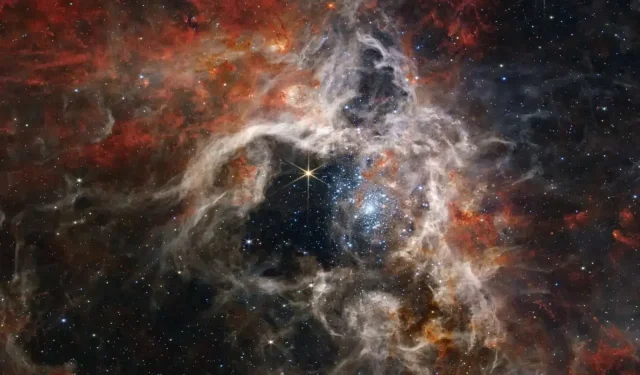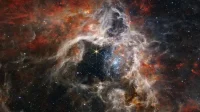The Tarantula Nebula imaged by the James Webb Telescope. Luxurious footage that can lift the veil on star formation.
The Tarantula Nebula has been photographed by several observatories in the past, but new images from the James Webb Telescope now give us a clearer and more accurate picture of the region. The Tarantula Nebula, also known as 30 Doradus, is the largest nebula known to date, making it a favorite target for scientists studying star formation.
The Tarantula Nebula imaged by the James Webb Telescope.
Astronomers used the telescope’s three infrared instruments to capture this image of the Tarantula Nebula. When viewed through a near-infrared camera (NIRCam), the filaments that give the nebula’s name can be seen surrounding a cluster of huge young stars glowing blue in the center of the image above. Tens of thousands of these young stars hidden in cosmic dust have never been seen before, according to NASA. The stellar winds and radiation from these young stars have formed the center of the nebula, which is constantly changing shape. The filaments surrounding them hide even more protostars, they will appear to join other stars in the center, pushing gas and dust away from our field of view.
Luxurious images that can lift the veil of star formation
The near-infrared spectrograph of the James Webb Telescope even observed one of these stars beginning to emerge from the dust. NASA says the star’s activity would not have been detected without the telescope’s high-resolution infrared spectrum. The astronomers also used the Mid-Infrared Instrument (MIRI) to observe the nebula in the longer infrared and produce a slightly different image from the one taken by NIRCam. This time around, the young stars at the center of the nebula fade into the background, while the cooler gases and dust surrounding them shine and jump out in front of us, as you can see below.
Tarantula Nebula, MIRI NASA, ESA, CSA, STScI, Webb ERO Production Group.
As NASA explains, the Tarantula Nebula is of particular interest to scientists studying star formation because its chemical composition is similar to nebulae that existed when the universe did not yet exist, they were only a few billion years old, and star formation was at its peak. our own galaxy does not have a region producing new stars at this rate. Moreover, these regions in the Milky Way have a different composition. By pointing the telescope at the Tarantula Nebula, scientists now have images that can be compared to numerous observations of much more distant galaxies, which could help better understand the early days of our universe.


